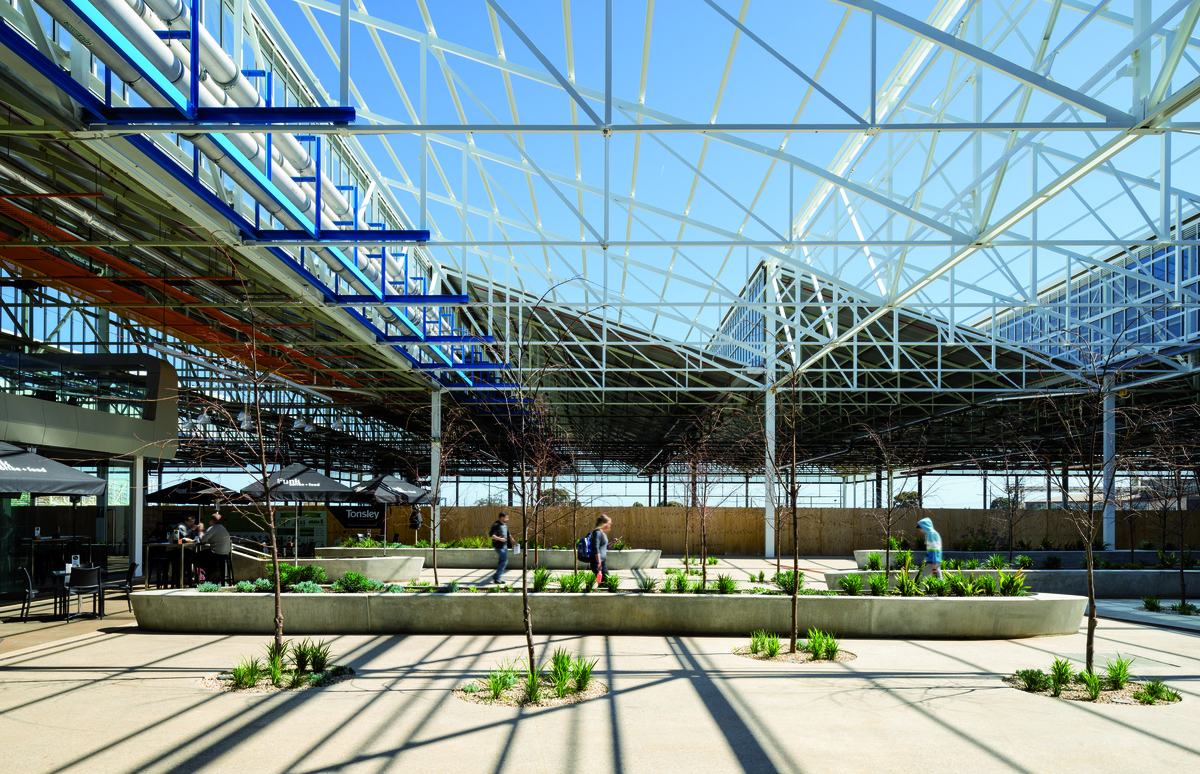
From the architect:
The Tonsley mixed-use redevelopment was Australia's first to be awarded the 6 Star Green Star – Communities certification by the Green Building Council of Australia. World class in its ambitions, it sets a new benchmark for sustainable urban regeneration and symbolises Adelaide's transition from a manufacturing to a knowledge economy.
Against the backdrop of Australia's declining manufacturing economy, the site of the former Mitsubishi car factory has been transformed into a vibrant knowledge precinct supporting clean technologies, sustainable industries, advanced manufacturing, education, and research.
The repurposing of the Main Assembly Building is the work of global architecture studio Woods Bagot, with Adelaide-based Tridente Architects. Since its completion in 2015 it has been recognised with national and international awards for sustainable architecture, urban renewal and adaptive re-use. The broader precinct has also just been honoured with the Property Council of Australia's 2018 award for best development innovation.
The building's design foretold what a new industrial employment precinct could look like. The ‘umbrella’ of the existing structure celebrates the industrial heritage of the building, creates a unique public destination, and delivers a clear layout with a highly flexible work environment. The tenancies use a ‘pod’ approach that is adaptable, flexible and highly functional.

“Rather than follow the typical industrial park approach, which would have had limited value to industry and the wider community, we chose to imagine a thriving community within the significant industrial remains of the Tonsley site,” says Milos Milutinovic, project leader for Woods Bagot.
Sustainability was paramount – not only in environmentally sustainable design but also through the economic, social and cultural impact of the site's regeneration. Being a sustainability leader was a key ambition in the redevelopment of the entire 610,000sqm site masterplanned by Woods Bagot.
Bringing together leading research and education institutions, established businesses and start-ups, as well as government and community groups, Tonsley will one day be home to around 1,200 residents in 850 dwellings. More than 70 businesses already operate from this technology test-bed.
The design was derived through scientific environmental analysis, which informed the approach to internal planning. Computer modelling was carried out to align appropriate daylight levels, thermal and acoustic performance by allocating a specific ratio of solid panels, transparent panels and openings to each space typology. The project team also utilised computational fluid dynamics modelling to derive façade and roof permeability for optimal cross ventilation for user comfort throughout the year.

"A critical issue of contemporary culture and the architectural profession is the role architecture can play in repairing the built environment and giving new life to tired places for great community benefit," says Woods Bagot director Thomas Masullo.
"It's a great honour to present Tonsley on the world stage, and to advocate for the relevance of architecture, particularly in re-thinking the design of our cities, public places and buildings for a viable future."
SUSTAINABILITY FEATURES
- The adaptive re-use of the Main Assembly Building saved 90,000 tons of embodied carbon, equivalent to 25,000 cars being taken off the road
- A 4 megawatt solar array on the roof produces affordable and sustainable energy for tenants
- Communications infrastructure provides connected technology as a basis for a Smart Grid Energy system
- Four urban forests inside the building provide naturally shaded green spaces, cool the air and reduce the sun’s thermal load on the roof

